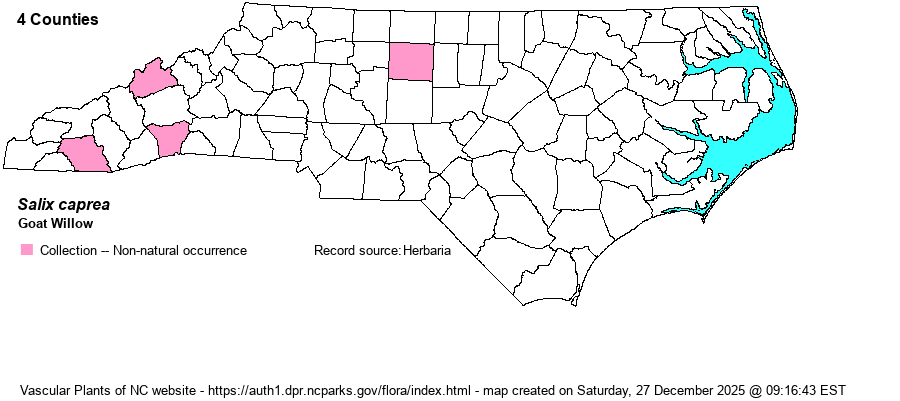| Author | L. | |
| Distribution | Mostly the southern Mountains, plus Guilford County in the Piedmont. Not all specimens at SERNEC were annotated by G. Argus and so could actually be S. cinerea.
Native of Europe; in N.A. scattered in eastern US and Ont.; NE, WA. | |
| Abundance | Very rare; nonetheless, it is a troubling species in one or more bogs, where it has impacted some rare plants. | |
| Habitat | Creeksides, dam and canal by river, bogs. | |
| Phenology | Flowering late February-April. | |
| Identification | Goat Willow is a tall shrub or small tree to 50 feet. Leaves are elliptical to obovate, margins entire to crenate, underside tomentose when young and becoming sparsely hairy and glaucescent when mature. Twigs are smooth (vs. with obvious ridges an inch or more long in S. cinerea and S. atrocinerea). | |
| Taxonomic Comments | The genus Salix is a very large and complex group of plants that vary from ground-hugging Arctic belly plants to huge trees. There are 113 species in North America alone, including introduced species. They are extremely important to browsing mammals -- rabbits, deer, elk, muskox, moose, many rodents -- and browsing birds like ptarmigan. Many birds use them to nest in. Here in NC we only have a small number of native species (5) and so do not appreciate the ecological importance of willows. We highly recommend reading the introductory pages of George Argus's FNA treatment (2010) and his excellent monograph on the willows of the southeastern U.S. (1986). The latter has drawings and descriptions of all southeastern U.S. taxa. Due to natural and horticultural hybridization, some plants will not key cleanly and you may have to compare your specimen with others verified by Argus. | |
| Other Common Name(s) | | |
| State Rank | SE | |
| Global Rank | GNR | |
| State Status | | |
| US Status | | |
| USACE-agcp | OBL link |
| USACE-emp | OBL link |

